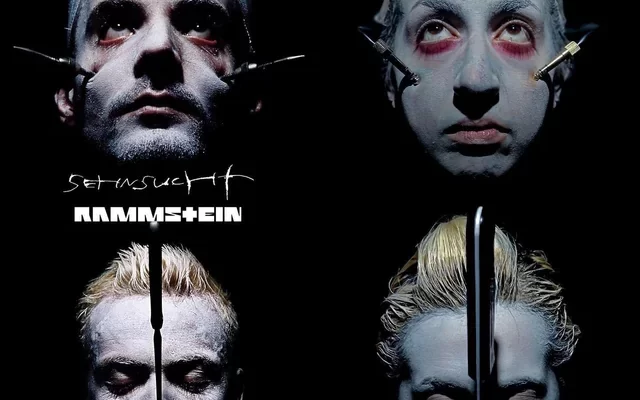In 1997, Rammstein’s second album Sehnsucht exploded onto the global stage and redefined what “breaking through” could mean for a German‑language metal band. What was already brewing from their debut Herzeleid now crystallized in a ferocious, theatrical, industrial metal maturation. With the singles “Engel” and “Du Hast”, they didn’t just smash charts in Germany — they pierced through language barriers, drawing in new listeners across continents and putting Neue Deutsche Härte firmly on the world map.
By the time Sehnsucht appeared on 22 August 1997 (22 August in Europe, and later in the U.S. via Slash Records) , Rammstein had already laid some of the groundwork for their leap forward. Their debut album Herzeleid (1995) had earned a passionate cult following, especially in German-speaking areas. But it was not until Sehnsucht that everything aligned: monster riffs, slick production, audacious visuals, and calculated single selection.
The first single, “Engel”, dropped earlier in the year — April 1997 — and became a harbinger of the scale this album was aiming for.“Engel” climbed charts and earned gold status in Germany by May prompting a “Fan Edition” release with bonus tracks “Feuerräder” and “Wilder Wein”. That bold confidence in remixing and reissuing the single hinted at the band’s intention to do more than merely exist in the German metal underground.
Then came “Du Hast”, unleashed in July 1997, which cracked into the German singles top 5 almost immediately “Du Hast” was faster, leaner, more punishing than “Engel” — a brutal call-and-response anthem with an almost militaristic precision to its rhythm and a near-perfect marriage of electronics, guitar, and dissonance. As Loudersound put it, it remains the song that “broke them in North America … a dancefloor‑filler … heavy, catchy.”
When Sehnsucht officially dropped, the reception was electric. Within two weeks, it held the No. 1 slot in Germany, and it also debuted at the top in Austria and charted high across Europe.) Remarkably, Sehnsucht became the only album entirely in German to be certified platinum by the RIAA in the U.S. Worldwide, it sold over 3.2 million copies, making it the band’s most commercially successful record
But numbers alone don’t tell the full story. The true ignition was in how Rammstein leveraged imagery, sound, and mystique. The album’s cover art — created by Austrian artist Gottfried Helnwein — featured six different portraits (one for each band member) depicting facial mutilation with wires and surgical instruments. The booklet folded out to reveal these deranged visages, immediately marking the record as not just a sonic assault, but a visual and emotional experience.That stark, unsettling imagery matched the band’s music: dark, daring, provocative. It was rock theatre masquerading as irony, punctuated with brutality.
“Engel,” by contrast, introduced a slightly more melodic flavor. Built on a sinewy groove and balancing a clean female vocal (by “Bobo”) over Till Lindemann’s deep voice, “Engel” had a haunting, seductive quality. It opened the door for listeners who might have balked at unrelenting aggression, giving them something to latch onto: melody, cadence, contrast The video — dark, dramatic, chiaroscuro — added to the mystique.
Meanwhile, tracks like “Bück dich,” “Spiel mit mir,” “Klavier,” and “Eifersucht” rounded out the album, delivering dynamic shifts and pacing that made Sehnsucht feel like a film score as much as a metal record. The interplay of silence and explosion, piano and distortion, restraint and fury, made the album a cohesive journey rather than a collection of singles.
Beyond the studio, the touring push was relentless. Rammstein carried Sehnsucht across Europe in the fall of 1997, headlining sold‑out dates and leveraging the momentum of their chart success.Their reach even stretched to the U.S. and other non‑German speaking markets, where “Du Hast” and “Engel” began appearing on MTV and specialty rock programs. A curious footnote: director David Lynch had earlier used two songs from Herzeleid (namely “Heirate mich” and “Rammstein”) in his 1997 film Lost Highway, pulling Rammstein into a limited but significant exposure in the American art/film world. That connection helped plant their seeds in U.S. countercultural ground even before Sehnsucht hit.
In the United States, Sehnsucht marked Rammstein’s effective debut. The band was marketed as a foreign explosive act, exotic and dangerous. But “Du Hast” broke through. Many listeners who didn’t understand German felt the power and texture rather than the literal meaning of the words. The visuals in the music videos — industrial backdrops, burning objects, galloping camera moves — translated the energy beyond language. That album became a bridge: you might not understand each line, but you could feel every stomp, every synth stab, every guttural yell.
The commercial results validated the gamble. Sehnsucht didn’t merely meet expectations — it exceeded them. It charted not only in German-speaking countries but across Europe, in Canada, and even placing in the U.S. Billboard 200.) With platinum status from the RIAA, it proved that a full German‑language album could find a substantial market in America — something nearly unheard of for heavy music at the time.
The cultural resonance was felt immediately in fan communities and music press. “Du Hast” became a staple of 1990s metal playlists — the kind of song that even non‑fans recognized. Loudersound later called it “their Smells Like Teen Spirit” — a blanket hit that defined their identity. (Louder) Meanwhile, the album’s darker corners — “Bestrafe mich,” “Klavier” — earned praise for bold experimentation. Many fans cite Sehnsucht as the moment Rammstein moved from national curiosity to global force.
In hindsight, Sehnsucht marked a singular moment in the 1990s metal explosion: the moment German, theatrical industrial metal broke its borders. It was audacious: to record in German, to embrace provocative art, to shoot arresting videos rather than nickel‑and‑dime promos. It was strategic: singles carefully chosen; imagery curated; touring aggressive. It was generational: the MTV era still had appetite for spectacle, and Rammstein filled that need. It was also rebellious in that it defied the assumption that English was the only route to global success.
As the decades passed, Sehnsucht’s myth only deepened. It gets anthologized in lists of best albums of 1997; it’s reissued in anniversary editions; original pressings are collector’s items because of the multiple cover variants. And live, Rammstein still open or intersperse classics from that album, raising the roof with “Du Hast,” “Engel,” or haunting interludes. Its influence is obvious: bands in industrial, metal, gothic, and crossover genres still reference that era.
In 1997, Sehnsucht wasn’t just an album release — it was a breakout, a declaration. With “Engel” and “Du Hast” acting as combustion points, Rammstein ignited a world for which they had no passport — but plenty of presence. They proved that language need not be a barrier, that aggression and artistry could coexist, and that German heavy music could demand global attention not by assimilation but by sheer force. That year, the world paid attention — and Rammstein never looked back.



